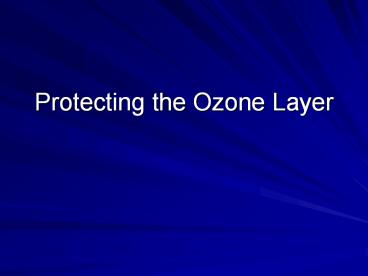Protecting the Ozone Layer - PowerPoint PPT Presentation
Title:
Protecting the Ozone Layer
Description:
Global Commons Problem. Non-excludable. Free access. Subtractable: more CFCs less ozone layer ... Drama of the Commons. The Ozone Layer Regime. Act I ... – PowerPoint PPT presentation
Number of Views:4070
Avg rating:3.0/5.0
Title: Protecting the Ozone Layer
1
Protecting the Ozone Layer
2
Stratospheric Ozone Depletion
- Ground-level (tropospheric) ozone harmful
pollutant - Stratospheric ozone shields the Earth surface
from UV rays.
3
Stratospheric Ozone Depletion
- F. Sherwood Rowland and Mario J Molina (1974)
- CFCs break down in the upper atmosphere
- Release chlorine
- Chlorine reacts with ozone,
- Ozone layer depletion
- Paul Crutzen (1970)
- Nitrogen oxides may deplete the ozone layer
- More UV radiation
- skin cancer, cataracts, damage to other
organisms, materials, crops
4
Global Commons Problem
- Non-excludable
- Free access
- Subtractable more CFCs less ozone layer
- Private benefits of averting depletion exceed
cost - No central governing authority
- Scientific uncertainty
- International cooperation required
5
- But No Tragedy of the Commons?
- Why?
6
- Drama of the Commons
- The Ozone Layer Regime
7
Act I Unilateral Action
- U.S. Regulations
- In 1978 US unilaterally banned the use of CFC
propellants in spray cans - Canada, Norway, Sweden
- Also restricted the use of CFC aerosols
8
Act IIDeadlock
- 1977-1985 complete deadlock , some symbolic
actions - Opponents to further regulation in US
- EC not interested to limit use in aerosols,
suspects US of using science to advance
commercial interests.
9
Act IIIThe Breakthrough
- The Vienna Convention on the Protection of the
Ozone Layer (1985) - -Encouraged research, cooperation among countries
and exchange of information. - -For the first time nations agreed in principle
to tackle a global environmental problem before
its effects were felt, or even scientifically
proven. - The Montreal Protocol (1987)
- Production and consumption of 5 CFCs to 50 of
1986 levels by June 30 1998. Freeze 3 Halons.
10
Act IIIBroaden Participation
- The 1990 London amendments
- Complete ban on 15 CFCs, 3 halons, carbon
tetrachloride by 2000, and methyl chloroform by
2005 - Multilateral Fund
- funds the incremental costs incurred by
developing countries in phasing out their
consumption and production of ODS. - 240 million fund over the following three years
- China, India and Brazil joined
11
Incentives for Developing Countries
- Later deadlines (10 years) for phasing substances
out in LDCs (Article V countries) - Trade restrictions
- Trade with non-parties restricted
- Multilateral Fund
- By 2001, 1.2 million contributed to the fund
3500 projects in 124 countries.
12
Act IVTight International Regulations
- Amendments adopted at Copenhagen (1992), Vienna
(1995), Montreal (1997) and Beijing (1999). - Ninety-six (96) chemicals are presently
controlled by the Montreal Protocol, including - Chlorofluorocarbons (CFCs) and Halons.
- Carbon tetrachloride
- Methyl chloroform
- Hydrochlorofluorocarbons
- Methyl bromide
13
Act VTragedy of the Commons Averted?
14
CFC Consumption
15
Ozone Hole
- 1988
- 2000
16
Caveats
- Imperfect compliance in Eastern Europe
- Illegal trade in CFCs
- Supply production still legal in some parts of
the world imperfect compliance by some former
communist countries - Demand older equipment (car AC, etc.), high
prices because of excise tax before total
phase-out.
17
Discussion
- What explains the success of the
- Montreal Protocol?
18
US Hegemony/Leadership
- US participation critical
- But institutions necessary
- Establish and strengthen scientific consensus
- Issue linkage and incentives to broaden
participation developing countries had
considerable negotiation leverage - Change negotiating proposal from aerosol ban to
comprehensive limits on ODS use and production - Address compliance problems Eastern Europe
illegal trade, other request for exemptions - Realist logic deceptively straightforward
19
Industrial Interests
- CFC substitutes found, but
- Alternatives known by 1980 in industry, but
active research abandoned - Research further advanced after 1986, by 1988
major advance in finding CFC alternatives - Concentrated benefits relatively small number
of actors - facilitate collective action - But regime still important
- Shift of industrial process/interests unlikely
without threat of regulations. - Even weak regime can motivate technological
innovation - Technology Assessment Process brought users and
smaller producers on board provided information
on the technical feasibility of reductions
20
The Role of Science
- Placed the issue on policy agenda
- Consensual science necessary for cooperation
- WMO/NASA Assessment (1986)-authoritative, peer
reviewed assessment on stratospheric ozone large
losses if CFCs grow by about 3 - Ozone Trends Panel (1988) ozone hole CFCs the
main culprits - Depends on participation, sponsorship,
procedures, outputs
21
Implications
- Institutions should allow adaptation
- Early targets important for innovation
irrespective of stringency - Feedback b/w regulation, technology and
innovation - Repeated negotiations and ratcheting up effects
- Authoritative, consensual science






























